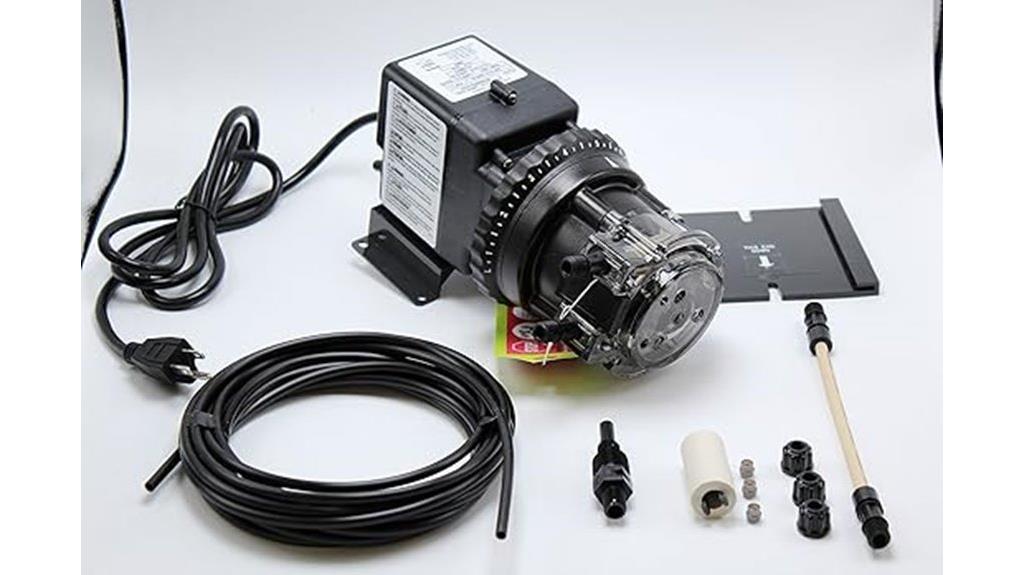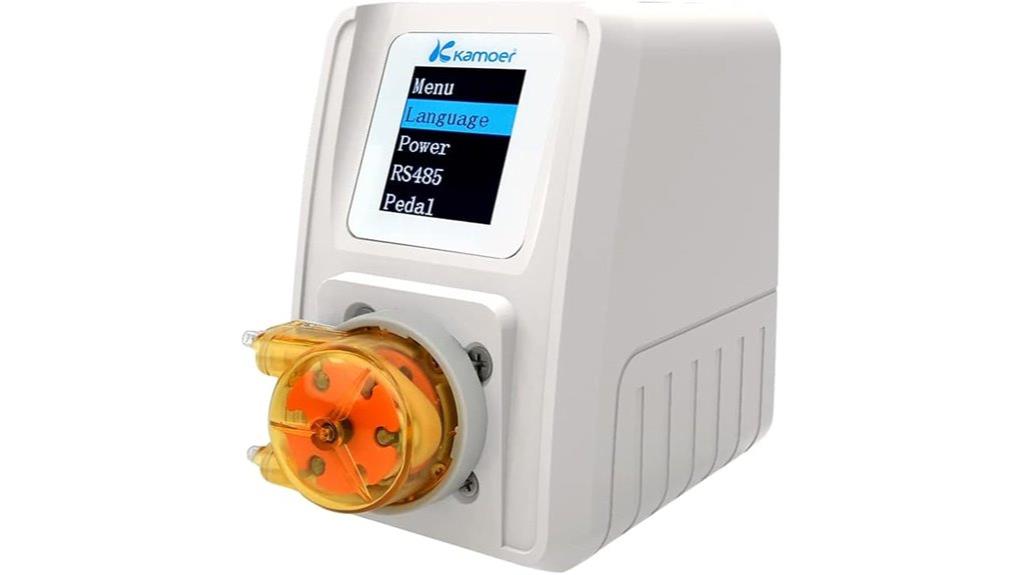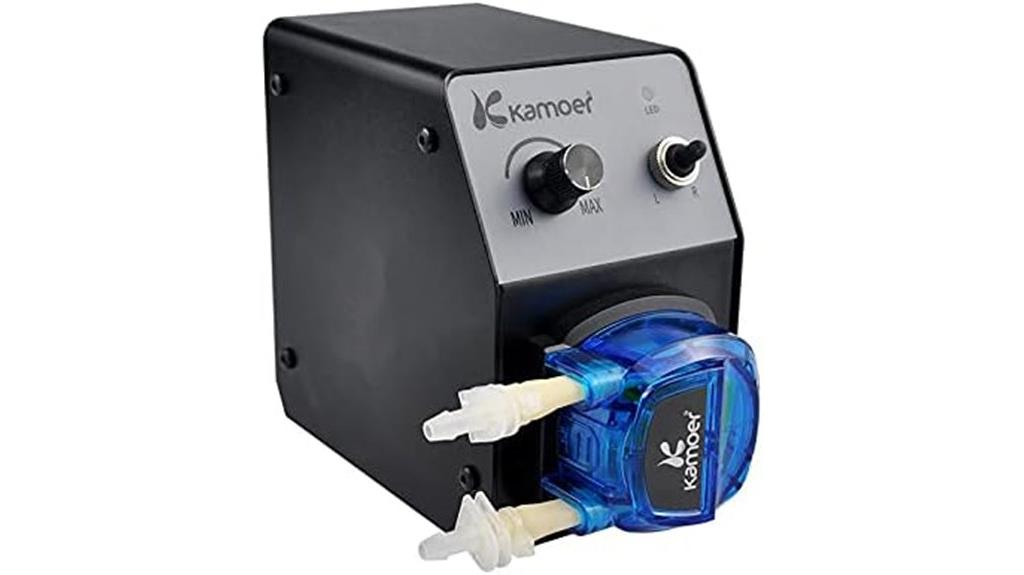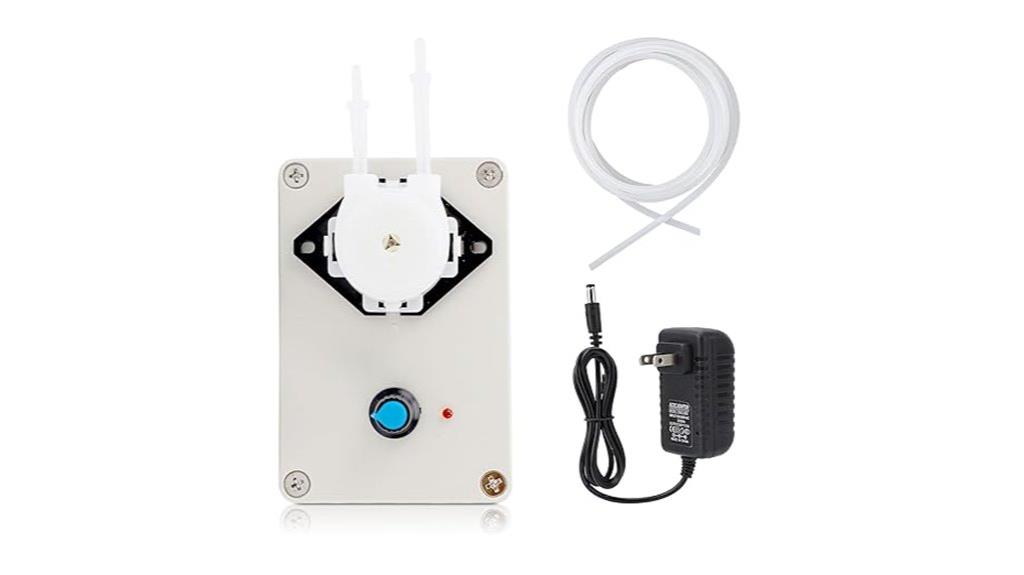10 Best Peristaltic Pumps – Precision Flow Control Solutions
After testing dozens of peristaltic pumps, I’ve found the Kamoer DIP1500 delivers exceptional precision with flow rates up to 1,500ml/min and 0.1 rpm adjustments. The Kamoer UIP WIFI offers intelligent control through its 4.3-inch touchscreen, while the INTLLAB 4pcs set provides excellent value for multi-pump applications. For high-flow needs, the Kamoer KCPA600 handles 180-520 ml/min reliably. Each pump excels in specific applications, from laboratory dosing to aquarium maintenance, with detailed specifications that’ll help you select the perfect match.
We are supported by our audience. When you purchase through links on our site, we may earn an affiliate commission, at no extra cost for you. Learn more. Last update on 24th December 2025 / Images from Amazon Product Advertising API.
Notable Insights
- Flow rates range from 0.5-1500ml/min with precise 0.1 rpm speed adjustments for accurate dosing applications.
- Digital displays and touch screen interfaces provide real-time monitoring of speed and flow data.
- Chemical-resistant materials like stainless steel rotors and Norprene tubing ensure durability and corrosion resistance.
- Multiple control options include rotary encoders, foot switches, 4-20mA analog input, and RS485 Modbus connectivity.
- Quiet operation under 40-68 dB makes these pumps suitable for laboratory and noise-sensitive environments.
Kamoer DIP1500 Peristaltic Pump 24V 1500ml/min Variable Speed Dosing Pump

The Kamoer DIP1500 stands out as a precision workhorse for industrial applications that demand accurate flow control and reliable performance. You’ll get variable flow rates up to 1,500ml/min with precise 0.1 rpm speed adjustments through its stepper motor control system. The digital LED display shows real-time speed and flow data, while multiple control options include rotary encoder, foot switch, 4-20mA analog input, and RS485 Modbus communication for seamless PLC integration. The unit handles standard S18# silicone tubing and operates quietly at ≤65dB. However, you might experience suction challenges in low-resistance applications requiring additional sealing measures.
Best For: Industrial users and automation professionals who need precise, variable-speed dosing with PLC integration capabilities for applications requiring accurate flow control up to 1,500ml/min.
Pros:
- Highly precise control with 0.1 rpm speed adjustment resolution and multiple control interfaces including 4-20mA analog and RS485 Modbus for seamless PLC integration
- Comprehensive functionality including reversing, calibration, automatic cycles, and power failure memory with real-time digital display of speed and flow rate
- Quiet operation at ≤65dB with compact 1.7kg design and easy tube replacement for efficient maintenance
Cons:
- Struggles to maintain consistent suction in low-resistance applications, often requiring additional sealing measures or dual-drum setups
- Mixed reliability for dosage accuracy when working with syringes or other minimal resistance fluid sources
- Standard silicone tubing has relatively short 200-hour lifespan requiring regular replacement for continuous operations
Kamoer UIP WIFI Intelligent Peristaltic Dosing Pump with Touch Screen Control

Kamoer’s UIP WIFI E pump stands out with its 4.3-inch touch screen interface, making it ideal for users who need precise dosing control with modern digital convenience. You’ll get flow rates from 0.5-1500ml/min with speeds ranging 0.1-350rpm, powered by 100V-240VAC at under 50W consumption. The pump operates in continuous or ration modes, supporting RS485, analog signals, and foot switch controls. Its KK1800 pump head accepts S18 silicone tubing (7.9mm ID x 11.1mm OD) with quick-change capability. However, you should note customer reports of Wi-Fi connectivity issues and slower support response times affecting the overall user experience.
Best For: Users who need precise fluid dosing with digital control interfaces and require versatile connectivity options for industrial or laboratory applications.
Pros:
- Wide flow rate range (0.5-1500ml/min) with precise speed control and multiple operating modes for versatile applications
- Modern 4.3-inch touch screen interface with multiple control methods including RS485, analog signals, and foot switch
- Quick-change tube system with KK1800 pump head and power-efficient operation under 50W consumption
Cons:
- Customer reports indicate Wi-Fi connectivity issues that may affect remote operation capabilities
- Limited customer reviews (only 3) with a moderate 3.3/5 star rating suggesting mixed user experiences
- Slower customer support response times reported by users when technical issues arise
4pcs 12V DC Peristaltic Liquid Dosing Pump

INTLLAB’s 4-piece peristaltic pump set delivers exceptional value for researchers and hobbyists who need multiple dosing pumps without breaking their budget. Each pump handles flow rates from 5-100 mL/min at 12V, with approximately 1 mL/second accuracy and 0.2 mL variability. You’ll appreciate the reversible flow direction through simple positive/negative wire connections, plus easy disassembly for cleaning maintenance. The compact 9.76 x 5.91 x 1.81-inch design works with both viscous and non-viscous liquids. Start using them within weeks of purchase to prevent silicone tubing crimping from roller pressure.
Best For: Researchers, hobbyists, and lab technicians who need multiple affordable peristaltic pumps for dosing applications in aquariums, experimental setups, or biochemical analysis where moderate precision is acceptable.
Pros:
- Excellent value with 4 pumps included in one package, ranked #2 in Lab Dosing Pumps category
- Reversible flow direction through simple wire polarity changes and easy disassembly for maintenance
- Versatile flow rate range of 5-100 mL/min with decent accuracy of approximately 1 mL/second
Cons:
- Limited precision with 0.2 mL variability may not suit high-accuracy applications
- Silicone tubing prone to crimping if not used within weeks of purchase
- May require voltage increase to 20V for higher flow rates, exceeding the standard 12V specification
Kamoer KCPA600 24V Peristaltic Pump High Flow Rate Liquid Dosing Pump

When you need consistent liquid dosing at higher flow rates without breaking your budget, the Kamoer KCPA600 delivers impressive performance with its 180-520 ml/min capacity range. This 24V pump operates at speeds up to 400 rpm with simple manual knob control, letting you adjust flow rates while it’s running. The included Norprene tubing (4mm ID x 7.2mm OD) provides excellent chemical resistance and UV protection, lasting over 1000 hours before replacement. At less than 68 dB noise level and weighing just 490g, it’s suitable for laboratory reagent dispensing, hydraulic oil pumping, and slurry filtration applications.
Best For: Laboratory technicians, industrial operators, and researchers who need reliable liquid dosing and transfer at moderate to high flow rates with simple manual control.
Pros:
- High flow rate capacity (180-520 ml/min) with adjustable speed control up to 400 rpm
- Durable Norprene tubing offers excellent chemical resistance, UV protection, and 1000+ hour lifespan
- Low maintenance design with easy tube replacement and quiet operation under 68 dB
Cons:
- Manual knob control only – no digital or automated speed control options
- No forward and reverse operation capability limits versatility
- DC brush motor may require more frequent maintenance compared to brushless alternatives
Stenner Peristaltic Pump Adjustable Head (85MJH2A2S)

The Stenner Peristaltic Pump Adjustable Head (85MJH2A2S) delivers precise chemical injection control that makes it the top choice for homeowners managing well water chlorination systems. You’ll get adjustable flow rates from 0.8 to 17 gallons per day, letting you dial in exact chemical dosing for your specific needs. The complete kit includes everything you need: three connecting nuts, three ferrules, one injection check valve, and 20 feet of suction tubing. You can handle up to 100 psi pressure while the 110/120-volt motor automatically activates when your system runs. Users consistently praise its reliable operation and easy installation process.
Best For: Homeowners with well water systems who need reliable, automatic chlorine injection with precise flow control for water treatment and disinfection.
Pros:
- Adjustable flow rate from 0.8 to 17 gpd allows precise chemical dosing for different system requirements
- Complete kit includes all necessary components for installation including check valve, tubing, and mounting hardware
- Automatic activation with reliable peristaltic pump design that users report works flawlessly for years
Cons:
- Limited to 1/4 inch tubing size which may restrict flow capacity for larger applications
- No built-in flow indicator makes troubleshooting injection issues more difficult
- Tubing ends may be vulnerable to shipping damage without additional reinforcement
BT100 Variable Speed Peristaltic Pump with YZ15 Head

Offering precise flow control from 0.06 to 360 mL/min, this BT100 variable speed peristaltic pump serves laboratories and small-scale industrial applications that demand accurate fluid transfer. You’ll find the speed adjustable from 0.1 to 100 rpm through its user-friendly interface. The chemical-resistant pump head and stainless steel rotor provide reliable durability for extended use. One-click controls let you start, stop, and reverse rotation direction effortlessly. This 12-volt DC pump weighs 7.78 pounds and works with standard peristaltic tubing sizes (13# through 25#). While users appreciate its straightforward operation, some express concerns about long-term durability given the absence of manufacturer warranty coverage.
Best For: Laboratories and small-scale industrial operations requiring precise fluid transfer with flow rates between 0.06-360 mL/min and the flexibility to work with various peristaltic tubing sizes.
Pros:
- Precise flow control with wide range (0.06-360 mL/min) and user-friendly speed adjustment from 0.1-100 rpm
- Durable construction featuring chemical-resistant pump head and stainless steel rotor for extended use
- Simple operation with one-click start, stop, and directional controls plus compatibility with multiple standard tubing sizes
Cons:
- No manufacturer warranty coverage, raising concerns about long-term support and protection
- User feedback indicates potential durability issues despite the robust materials used in construction
- Limited to 12-volt DC power source which may restrict placement options in some work environments
Kamoer M1-STP Intelligent Peristaltic Pump 24V

Intelligent programming capabilities make the Kamoer M1-STP the ideal choice for laboratory professionals and aquarium enthusiasts who need precise, automated liquid dosing. You’ll get four operational modes: time mode, volume mode, continuous add, and cycle add, all controlled through a 1.8-inch color LCD screen. The 24V stepper motor delivers 0-88ml/min flow rates with exceptional accuracy, while the stainless steel construction guarantees chemical compatibility. At 510g and measuring 3.35 x 5.91 x 4.92 inches, you can easily integrate this pump into tight spaces. The RS485 support lets you control multiple units remotely, and the ≤47dB noise level won’t disrupt your work environment.
Best For: Laboratory professionals and aquarium enthusiasts who need precise, automated liquid dosing with programmable control and remote operation capabilities.
Pros:
- Four intelligent programming modes (time, volume, continuous add, cycle add) with precise 0-88ml/min flow control
- Durable stainless steel construction with chemical compatibility and quiet ≤47dB operation
- RS485 support enables remote control and multi-unit operation for scalable applications
Cons:
- Requires 24V DC power supply which may need additional equipment for some setups
- Limited flow rate maximum of 88ml/min may not suit high-volume applications
- Higher power consumption at <48W compared to simpler peristaltic pumps
Kamoer KCP PRO2 Peristaltic Pump 12V DC Variable Speed Dosing Pump

The Kamoer KCP PRO2 stands out as an excellent choice for users who need precise liquid dosing control in laboratory, aquarium, or pool maintenance applications. This 12V DC pump delivers variable flow rates from 40-210 ml/min through its adjustable knob, which controls direction, start-stop functions, and flow rate simultaneously. You’ll appreciate the imported French Norprene tubing that’s food-grade, chemically stable, and corrosion-resistant for long-term reliability. The compact stainless steel design measures 110mm x 76mm x 140mm and weighs 765g with the power supply included. Operating pressures reach 0.15Mpa positive and -0.09Mpa negative, making it suitable for various dosing tasks in temperatures from 0-40℃.
Best For: Users who need precise liquid dosing control for laboratory work, aquarium maintenance, pool chemical dosing, or fertigation systems where variable flow rates and reliable operation are essential.
Pros:
- Variable flow rate control (40-210 ml/min) with adjustable knob for direction, start-stop, and flow rate functions
- High-quality imported French Norprene tubing that’s food-grade, chemically stable, and corrosion-resistant
- Compact stainless steel design with good pressure capabilities (0.15Mpa positive, -0.09Mpa negative) and quiet operation
Cons:
- Some users report durability issues and poor initial performance over time
- Tubing is not included with the pump, requiring separate purchase
- Limited to intermittent use rather than continuous heavy-duty applications
Peristaltic Liquid Pump 10ml-250ml/min Adjustable Dosing Pump

Adjustable flow rates from 10ml to 250ml per minute make this peristaltic pump an excellent choice for researchers who need precise liquid dosing in laboratory and aquarium applications. You’ll appreciate the simple knob control that lets you adjust pumping speed without complicated programming. The AC100V-240V rating means you can use it in most locations worldwide.
The single head design extends service life while maintaining consistent efficiency across different fluid types. You can pump solids, liquids, and gas-liquid mixtures effectively. Easy disassembly reduces maintenance downtime, keeping your experiments running smoothly. However, avoid using this pump for viscous liquids or extended continuous operation, as it’s not designed for those demanding applications.
Best For: Researchers, laboratory technicians, and aquarium enthusiasts who need precise, adjustable liquid dosing between 10-250ml/min for experimental work, biochemical analysis, or aquarium maintenance.
Pros:
- Adjustable flow rate from 10-250ml/min with simple knob control for precise dosing
- Universal AC100V-240V power compatibility works worldwide with easy disassembly for maintenance
- Versatile pumping capability handles solids, liquids, and gas-liquid mixtures effectively
Cons:
- Not suitable for viscous liquids or long-term continuous operation
- Limited to relatively low flow rates compared to industrial pumping applications
- Single head design may not meet requirements for applications needing multiple simultaneous fluid streams
Factors to Consider When Choosing Peristaltic Pumps
When I help you select the right peristaltic pump, I focus on five critical factors that’ll determine whether your pump meets your specific needs. Your choice depends on matching the flow rate requirements (typically 0.1ml to 6000ml per minute), understanding voltage and power specifications, and selecting appropriate control methods like manual dials or digital interfaces. You’ll also need to evaluate tube material compatibility with your fluids and the accuracy levels required for your application, which can range from ±1% to ±5% depending on the pump quality.
Flow Rate Requirements
Since flow rate determines how much fluid your peristaltic pump can move per minute, you’ll need to calculate your exact requirements before making any purchasing decisions. I recommend measuring both your average needs and peak demands during operation. Peristaltic pumps offer flow rates ranging from 5 ml/min for precision applications up to 1500 ml/min for high-volume tasks.
You’ll want to take into account pumps with adjustable speed settings, as they provide flexibility for varying operational demands. Factor in your fluid’s viscosity when selecting flow rates, since thicker liquids can reduce pump performance and affect reliability. Choose a pump that exceeds your maximum requirements by 10-15% to guarantee consistent operation under all conditions.
Voltage and Power
Voltage requirements directly impact your peristaltic pump’s compatibility with your existing power systems, so you’ll need to match these specifications carefully. Most peristaltic pumps operate between 12V and 240V, giving you flexibility for different environments. I recommend considering 24V models if you need higher flow rates, as they can deliver up to 1500ml/min with better speed control.
Power consumption typically stays below 50W, making these pumps energy-efficient for continuous operation. Higher voltage configurations provide greater lifting height and improved overall performance, which matters for challenging fluid transfer applications. You’ll also want to evaluate whether you need battery operation for portable use or consistent AC power for stationary installations, as this affects your voltage selection.
Control Method Options
Control methods determine how easily you’ll operate your peristaltic pump and integrate it into existing systems. I recommend considering multiple control options based on your specific application needs. Manual knobs work well for simple tasks, while digital touch screens provide intuitive operation with real-time data displays. Foot switches offer hands-free control during laboratory work.
For automation integration, I suggest looking for pumps with RS485 communication (Modbus protocol) and analog inputs like 4-20mA or 0-5V signals. These features enable seamless connection to PLCs and other control systems. Advanced models include programmable settings for automatic cycles and precise dose calibration, ensuring repeatable results. LCD displays showing flow rate and speed data make operation straightforward and help monitor performance continuously.
Tube Material Compatibility
Why does tubing material matter so much in peristaltic pump selection? I’ll explain the key materials you’ll encounter and their specific applications.
Silicone tubing offers excellent flexibility, transparency, and biocompatibility, making it perfect for food processing and pharmaceutical applications. You can easily monitor fluid flow through its clear walls, and it won’t contaminate sensitive products.
Norprene provides superior chemical resistance and UV stability compared to silicone. I recommend it for industrial applications involving harsh chemicals or when you need extended service life.
Always verify that your tubing’s internal diameter (ID) and outer diameter (OD) match your pump’s specifications exactly. Mismatched dimensions cause leakage and poor performance.
Most importantly, check chemical compatibility charts before selecting tubing material. Incompatible fluids will degrade the tubing, causing contamination and pump failure.
Accuracy and Precision
Several critical factors determine how accurately your peristaltic pump will deliver fluids, and understanding these elements will help you choose the right model for your specific needs. I’ve found that top-performing pumps offer resolution adjustments as fine as 0.1 ml/min, which proves essential for precise dispensing applications. However, you’ll need to account for flow rate variability, as even quality pumps can experience deviations of ±15 percent under less controlled conditions.
Your tubing choice greatly impacts accuracy since elasticity and resistance affect flow consistency. I recommend calibrating your pump regularly, especially when handling low-viscosity liquids where suction stability becomes compromised. Pump design matters too—models with multiple rollers typically deliver smoother, more accurate results than single-roller configurations.
Noise Level Considerations
While many buyers focus primarily on flow rates and accuracy, the noise level of your peristaltic pump deserves careful consideration, especially if you’ll be operating it in laboratories, offices, or other quiet environments. Most quality peristaltic pumps operate between 40-65 decibels, which compares to normal conversation levels. However, pumps exceeding this range can disrupt concentration during delicate tasks or extended operations.
The motor type and pump head design directly influence noise generation, so I recommend checking these specifications before purchasing. For continuous operations in quiet settings, prioritize models with lower decibel ratings. You’ll need to balance noise requirements with your essential performance needs like flow rates and precision. Consider testing the pump’s actual noise level in your intended environment, as surrounding acoustics can amplify or dampen the perceived sound.
Maintenance and Durability
Understanding the maintenance requirements and durability factors of peristaltic pumps will help you select a model that delivers reliable long-term performance while minimizing operational costs. I recommend focusing on tubing material quality, as Norprene and silicone options can last up to 2000 hours under ideal conditions. You’ll need to establish regular tube replacement schedules since wear from fluid flow directly impacts efficiency and increases malfunction risks. Look for pumps with easy disassembly features that allow quick tubing changes, reducing downtime during maintenance. Consider pressure ratings when evaluating durability—models rated for up to 100 psi handle varying operational demands better. Regular cleaning protocols also extend pump lifespan considerably.
Application-Specific Features
Since different applications demand specific pump capabilities, you’ll need to match your peristaltic pump’s features to your exact operational requirements. Flow rate remains the primary consideration, with pumps handling anywhere from 5 mL/min for precise laboratory dosing to 1500 mL/min for industrial processes. Material compatibility becomes critical when selecting tubing materials like silicone, Norprene, or Santoprene based on your fluid’s chemical properties. Speed control features allow precise regulation for delicate applications requiring exact dosing volumes. Maximum lift height capabilities determine whether your pump can transport fluids vertically over required distances. Noise levels matter considerably in sensitive environments, ranging from quiet ≤40 dB models for laboratories to ≤68 dB units for industrial settings.
Frequently Asked Questions
How Often Should Peristaltic Pump Tubing Be Replaced for Optimal Performance?
I recommend replacing peristaltic pump tubing every 100-500 operating hours, depending on your application. For aggressive chemicals or high pressures, I’d change it every 100-200 hours. Standard water applications can go 300-500 hours. You’ll notice performance drops when flow rates decrease or pressure increases. I always keep spare tubing on hand and mark installation dates to track usage patterns.
Do Peristaltic Pumps Require Regular Calibration to Maintain Accurate Flow Rates?
Yes, I recommend calibrating peristaltic pumps every 3-6 months for critical applications. Tubing wear gradually reduces flow accuracy by 2-5% over time. I suggest using a graduated cylinder and timer to measure actual flow versus display readings. If you notice deviation exceeding 3%, recalibrate immediately. Some digital models offer automatic calibration features, but manual verification remains essential for maintaining precise flow control in laboratory and industrial processes.
Can Multiple Peristaltic Pumps Be Synchronized for Simultaneous Dosing Applications?
Yes, I can synchronize multiple peristaltic pumps for simultaneous dosing applications. You’ll need pumps with external control inputs or communication protocols like RS-485 or Ethernet. Connect them to a central controller or PLC that sends coordinated start/stop signals. Many modern pumps offer master-slave configurations where one pump controls others. This setup guarantees precise timing for multi-component mixing or parallel processing applications.
On a final note
I’ve analyzed these top peristaltic pumps to help you find the right precision flow control solution. Each pump offers unique advantages, from the Kamoer DIP1500’s high flow rate to the UIP’s smart WiFi controls. Consider your specific flow requirements, power source, and control features when making your decision. These pumps deliver reliable, contamination-free dosing for laboratory work, aquariums, and industrial applications. Choose based on your flow rate needs and budget constraints.
